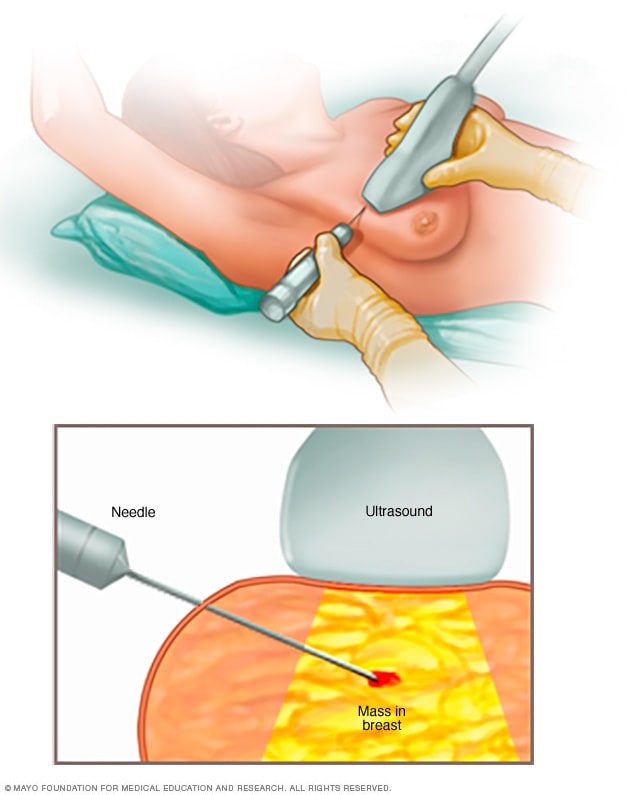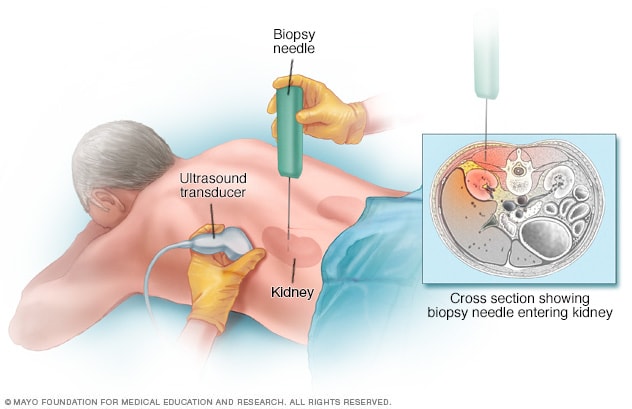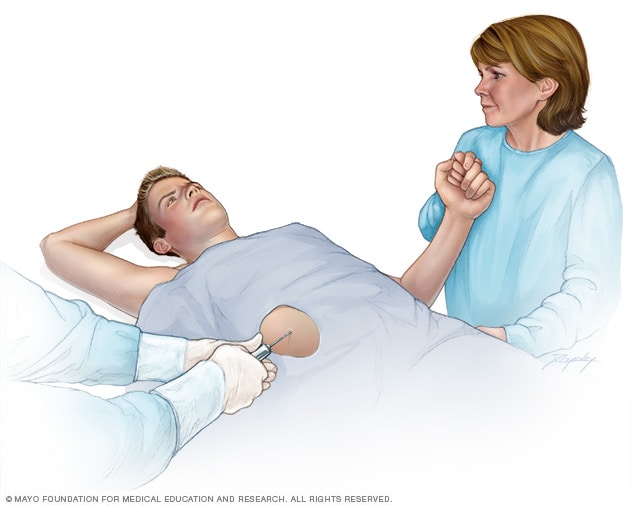Risks
Needle biopsy carries a small risk of bleeding and infection at the site where the needle is inserted. It's common to have some mild pain after needle biopsy. The pain usually can be controlled with pain relievers.
Call your healthcare professional if you experience:
- Fever.
- Pain at the biopsy site that worsens or isn't helped by medicines.
- Changes in the color of the skin around the biopsy site. It may look red, purple or brown depending on your skin color.
- Swelling at the biopsy site.
- Drainage from the biopsy site.
- Bleeding that doesn't stop with pressure or a bandage.
How you prepare
Most needle biopsy procedures don't require any preparation on your part.
Depending on what part of your body will be biopsied, your healthcare professional may ask you not to eat or drink before the procedure. Medicines are sometimes adjusted before the procedure. Follow your healthcare professional's instructions.
Preparing for sedation or general anesthesia
Sometimes you're given medicine to relax you during the needle biopsy. This medicine is called a sedative. Sometimes you need medicine to put you in a sleep-like state during the procedure. This medicine is called a general anesthetic. If you'll be having sedation or anesthesia, you may need to fast the day before your procedure. Tell your healthcare professional about any medicines you're taking, as you may need to stop taking certain medicines before anesthesia.
You may not be able to return to work or drive right after your procedure if your needle biopsy is done with sedation or general anesthesia. Talk with your healthcare professional about when it's safe to return to work.
Make arrangements or ask friends or family members to:
- Drive you home.
- Stay with you for 24 hours.
- Help with household chores for a day or two.
What you can expect
During the needle biopsy
Core needle biopsy

Core needle biopsy
A core needle biopsy uses a long, hollow tube to obtain a sample of tissue. Here, a biopsy of a suspicious breast lump is being done. The sample is sent to a lab for testing by doctors called pathologists. They specialize in examining blood and body tissue.
Kidney biopsy

Kidney biopsy
During a kidney biopsy, a healthcare professional uses a needle to remove a small sample of kidney tissue for lab testing. The biopsy needle is put through the skin to the kidney. The procedure often uses an imaging device, such as an ultrasound transducer, to guide the needle.
Liver biopsy

Liver biopsy
A liver biopsy is a procedure to remove a small sample of liver tissue for laboratory testing. A liver biopsy is commonly performed by inserting a thin needle through the skin and into the liver.
Your healthcare team positions you in a way that makes it safe for the healthcare professional to access the area where the needle will be inserted. You may be asked to lie flat on a table or sit up.
You may have an imaging test, such as a CT scan, MRI or ultrasound. This allows your healthcare professional to see the target area and plan the best way to take the biopsy. Imaging is sometimes done before your needle biopsy and sometimes used during the biopsy. What type of imaging you have, if any, depends on what part of your body is being biopsied.
Your healthcare team cleans the area of your body where the needle will be inserted. Numbing medicine may be injected into the skin around the area. For some procedures, you may be given a sedative or other medicine to relax you. Sometimes general anesthesia is used during a needle biopsy. If this is the case, you'll receive medicines through a vein in your arm to relax you and put you in a sleep-like state.
During the needle biopsy, the healthcare professional guides a needle through your skin and into the area of interest. You may be asked to hold your breath or keep very still. A sample of cells is collected and the needle is withdrawn. This process may be repeated several times until enough cells are collected.
Common types of needle biopsy techniques include:
- Fine-needle aspiration. This type of needle biopsy uses a thin, hollow needle to draw cells from your body.
- Core needle biopsy. This type of needle biopsy uses a wider needle than that used for fine-needle aspiration. The needle used during a core needle biopsy is a hollow tube. It allows the healthcare professional to extract a sample of tissue for testing.
You may feel mild discomfort or pressure in the needle biopsy area during the procedure. Tell your healthcare team if you're in pain.
After the needle biopsy
Once your healthcare professional has collected enough cells or tissue for testing, your needle biopsy procedure is complete. Your healthcare team may put a bandage over the area where the needle was inserted. You may be asked to apply pressure to the bandage for several minutes to help prevent bleeding.
Typically, you can leave when your needle biopsy procedure is finished. Whether you can leave right away depends on what part of your body was biopsied. Sometimes your healthcare team may want to watch you for a few hours to make sure you won't have complications.
If you received a sedative or general anesthetic, you'll likely be taken to a comfortable place to relax while the medicine wears off.
Plan to take it easy for the rest of the day. Protect the area where you received the needle biopsy by keeping the bandage in place for as long as instructed. You may feel a mild ache or pain in the area, but this should go away in a day or two.
Results
Needle biopsy results may take a few days to a week or more. Ask your healthcare professional how long you can expect to wait and how you'll get the results.
After your needle biopsy, your biopsy sample goes to a lab for testing. In the lab, doctors who specialize in studying cells and tissue for signs of disease will test your biopsy sample. These doctors are called pathologists. The pathologists create a pathology report with your results.
You can request a copy of your pathology report from your healthcare professional. Pathology reports are usually filled with technical terms. You may find it helpful to have your healthcare professional review the report with you.
Your pathology report may include:
- A description of the biopsy sample. This section of the pathology report, sometimes called the gross description, describes the biopsy sample in general. For instance, it may describe the color and consistency of the tissues or fluid collected with the needle biopsy procedure. Or it may say how many slides were submitted for testing.
- A description of the cells. This section of the pathology report describes how the cells look under a microscope. It may include how many cells and what types of cells were seen. Information on special dyes that were used to study the cells may be included.
- The pathologist's diagnosis. This section of the pathology report lists the pathologist's diagnosis. It may also include comments, such as whether other tests are recommended.
The results of your needle biopsy determine the next steps in your medical care. Talk with your healthcare professional about what your results mean for you.
Clinical trials
Explore Mayo Clinic studies of tests and procedures to help prevent, detect, treat or manage conditions.
The Mayo Clinic experience and patient stories
Our patients tell us that the quality of their interactions, our attention to detail and the efficiency of their visits mean health care like they've never experienced. See the stories of satisfied Mayo Clinic patients.